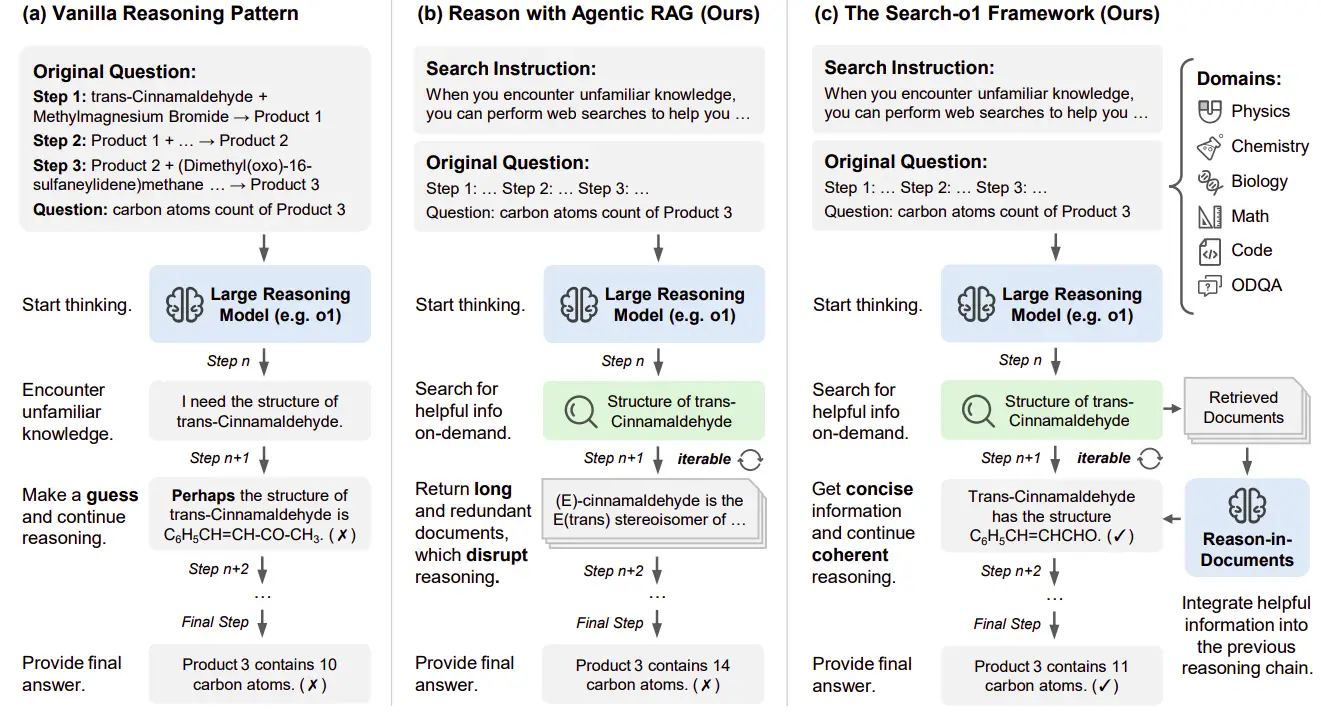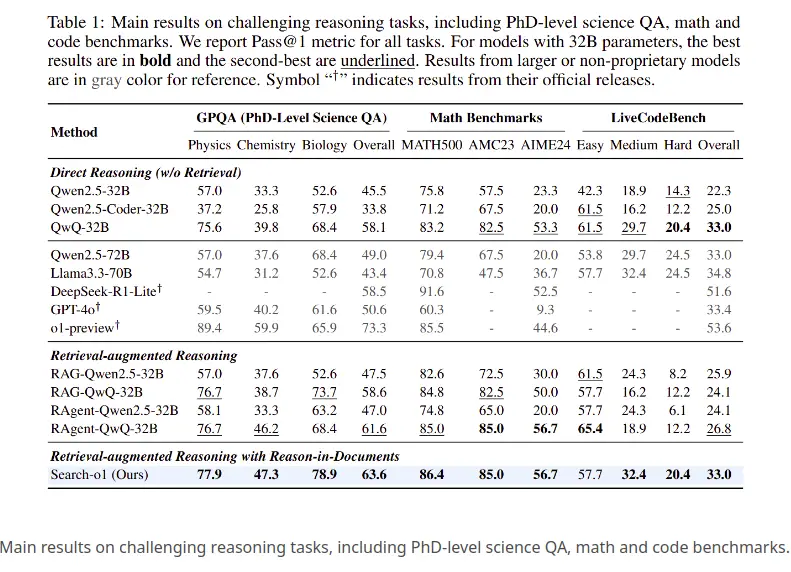How Does Search-o1 Improve Logical Flow in AI Reasoning?
AI's rapid advancements are pushing the boundaries of machine capabilities, exceeding expectations from just a few years ago. Large Reasoning Models (LRMs, exemplified by OpenAI-o1) are sophisticated systems tackling complex problems through a step-by-step approach. These models don't just solve problems; they methodically reason, employing reinforcement learning to refine their logic and produce detailed, coherent solutions. This deliberate process, often called "slow thinking," enhances logical clarity. However, a significant limitation remains: knowledge gaps. LRMs can encounter uncertainties that propagate errors, compromising final accuracy. Traditional solutions like increasing model size and expanding datasets, while helpful, have limitations, and even Retrieval-Augmented Generation (RAG) methods struggle with highly complex reasoning.
Search-o1, a framework developed by researchers at Renmin University of China and Tsinghua University, addresses these limitations. It seamlessly integrates task instructions, questions, and dynamically retrieved knowledge into a cohesive reasoning chain, facilitating logical solutions. Search-o1 augments LRMs with an agentic RAG mechanism and a Reason-in-Documents module to refine retrieved information.
Table of Contents
- What is Search-o1?
- Traditional Reasoning
- Agentic RAG
- The Search-o1 Framework
- Search-o1 Performance Across Benchmarks
- Science QA (GPoQA)
- Mathematical Problems
- LiveCodeBench (Code Reasoning)
- Chemistry Case Study from the GPQA Dataset
- The Problem
- The Model's Strategy
- Reasoning and Solution
- Key Insights
- Conclusion
What is Search-o1?
Unlike traditional models that struggle with incomplete knowledge or basic RAG methods that often retrieve excessive, irrelevant information, Search-o1 introduces a crucial Reason-in-Documents module. This module distills extensive data into concise, logical steps, ensuring accuracy and coherence.
The framework operates iteratively, dynamically searching for and extracting relevant documents, transforming them into precise reasoning steps, and refining the process until a complete solution is obtained. It surpasses traditional reasoning (hampered by knowledge gaps) and basic RAG methods (which disrupt reasoning flow). Through an agentic mechanism for knowledge integration and maintaining coherence, Search-o1 ensures reliable and accurate reasoning, establishing a new standard for complex problem-solving in AI.

Search-o1 tackles knowledge gaps in LRMs by seamlessly integrating external knowledge retrieval without disrupting logical flow. The research compared three approaches: traditional reasoning, agentic RAG, and the Search-o1 framework.
1. Traditional Reasoning
Determining the number of carbon atoms in a three-step chemical reaction's final product serves as an example. Traditional methods struggle when encountering knowledge gaps, such as lacking the structure of trans-Cinnamaldehyde. Without accurate information, the model relies on assumptions, potentially leading to errors.
2. Agentic RAG
Agentic RAG allows autonomous knowledge retrieval. If uncertain about a compound's structure, it generates specific queries (e.g., "structure of trans-Cinnamaldehyde"). However, directly incorporating lengthy, often irrelevant retrieved documents disrupts the reasoning process and reduces coherence due to verbose and tangential information.
3. Search-o1
Search-o1 enhances agentic RAG with the Reason-in-Documents module. This module refines retrieved documents into concise reasoning steps, seamlessly integrating external knowledge while preserving logical flow. Considering the current query, retrieved documents, and the evolving reasoning chain, it generates coherent, interconnected steps iteratively until a conclusive answer is reached.
Search-o1 Performance Across Benchmarks

Three challenging reasoning tasks were evaluated:
- Advanced Science QA (PhD-level questions in Physics, Chemistry, Biology),
- Complex Mathematical Problems (difficult problems from MATH500 and AMC23),
- Live Coding Challenges (real-world coding tasks categorized by difficulty).
1. Science QA (GPoQA)
- Direct Reasoning (No Retrieval): Models like Qwen2.5-32B (57.0%) and QwQ-32B (68.4%) lagged behind Search-o1 (77.9%).
- Retrieval-Augmented Reasoning: RAG-QwQ-32B (76.7%) performed well but still fell short of Search-o1's accuracy. Search-o1 demonstrated superior performance in Physics (78.9%) and Chemistry (47.3%).
2. Math Benchmarks
- Direct Reasoning: QwQ-32B (83.2%) performed best among direct methods, but Search-o1 (86.4%) surpassed it.
- Retrieval-Augmented Reasoning: RAG-QwQ-32B (85.0%) was close, but Search-o1 maintained a lead, highlighting the benefit of its structured reasoning.
3. LiveCodeBench (Code Reasoning)
- Direct Reasoning: Qwen2.5-Coder-32B (22.5%) and QwQ-32B (33.0%) were outperformed by Search-o1 (33.0%).
- Retrieval-Augmented Reasoning: RAG methods significantly underperformed compared to Search-o1.
Key Findings:
- Superior Performance: Search-o1 consistently outperformed other methods due to its iterative reasoning approach.
- Reason-in-Documents Module's Impact: This module ensured focused reasoning, providing an advantage over direct and RAG approaches.
- Robustness: While some methods excelled in specific tasks, Search-o1 demonstrated balanced performance across all categories.
Search-o1 proved the most effective method across all tasks, setting a new standard by combining retrieval and structured reasoning. The framework addresses knowledge insufficiency by integrating RAG with the Reason-in-Documents module, enabling more effective use of external knowledge. This forms a strong foundation for future research in retrieval systems, document analysis, and intelligent problem-solving.
Chemistry Case Study from the GPQA Dataset
This case study illustrates how Search-o1 answers a chemistry question from the GPQA dataset using retrieval-augmented reasoning.
The Problem
Determine the number of carbon atoms in the final product of a multi-step reaction involving trans-cinnamaldehyde.
The Model's Strategy
- Problem Decomposition: The model analyzed the reaction step-by-step, identifying key components and how carbon atoms are added.
- External Knowledge Retrieval: The model queried information about reaction mechanisms, retrieving data on Grignard reagent reactions with aldehydes and the structure of trans-cinnamaldehyde.
- Subsequent Reaction Analysis: The model tracked carbon atom changes throughout each reaction step.
- Initial Structure Verification: The model verified the initial carbon atom count in trans-cinnamaldehyde.
- Final Reaction Analysis: The model analyzed the final reaction, determining the total carbon atoms in the final product.
Reasoning and Solution
The model concluded that the final product contains 11 carbon atoms (starting with 9, adding one from the Grignard reaction, and another in the final step). The answer is 11.
Key Insights
- Effective Knowledge Use: Targeted searches filled knowledge gaps.
- Iterative Reasoning: Methodical step-by-step analysis ensured accuracy.
- Error Checking: The model re-evaluated assumptions, ensuring accuracy.
Conclusion
Search-o1 represents a significant advancement in LRMs, addressing knowledge insufficiency. By integrating agentic RAG and the Reason-in-Documents module, it enables seamless, iterative reasoning that incorporates external knowledge while maintaining logical coherence. Its superior performance across diverse domains sets a new standard for complex problem-solving in AI. This innovation enhances reasoning accuracy and opens avenues for research in retrieval systems, document analysis, and intelligent problem-solving, bridging the gap between knowledge retrieval and logical reasoning. Search-o1 establishes a robust foundation for the future of AI, enabling more effective solutions to complex challenges.
The above is the detailed content of How Does Search-o1 Improve Logical Flow in AI Reasoning?. For more information, please follow other related articles on the PHP Chinese website!

Hot AI Tools

Undresser.AI Undress
AI-powered app for creating realistic nude photos

AI Clothes Remover
Online AI tool for removing clothes from photos.

Undress AI Tool
Undress images for free

Clothoff.io
AI clothes remover

Video Face Swap
Swap faces in any video effortlessly with our completely free AI face swap tool!

Hot Article

Hot Tools

Notepad++7.3.1
Easy-to-use and free code editor

SublimeText3 Chinese version
Chinese version, very easy to use

Zend Studio 13.0.1
Powerful PHP integrated development environment

Dreamweaver CS6
Visual web development tools

SublimeText3 Mac version
God-level code editing software (SublimeText3)

Hot Topics
 Getting Started With Meta Llama 3.2 - Analytics Vidhya
Apr 11, 2025 pm 12:04 PM
Getting Started With Meta Llama 3.2 - Analytics Vidhya
Apr 11, 2025 pm 12:04 PM
Meta's Llama 3.2: A Leap Forward in Multimodal and Mobile AI Meta recently unveiled Llama 3.2, a significant advancement in AI featuring powerful vision capabilities and lightweight text models optimized for mobile devices. Building on the success o
 10 Generative AI Coding Extensions in VS Code You Must Explore
Apr 13, 2025 am 01:14 AM
10 Generative AI Coding Extensions in VS Code You Must Explore
Apr 13, 2025 am 01:14 AM
Hey there, Coding ninja! What coding-related tasks do you have planned for the day? Before you dive further into this blog, I want you to think about all your coding-related woes—better list those down. Done? – Let’
 AV Bytes: Meta's Llama 3.2, Google's Gemini 1.5, and More
Apr 11, 2025 pm 12:01 PM
AV Bytes: Meta's Llama 3.2, Google's Gemini 1.5, and More
Apr 11, 2025 pm 12:01 PM
This week's AI landscape: A whirlwind of advancements, ethical considerations, and regulatory debates. Major players like OpenAI, Google, Meta, and Microsoft have unleashed a torrent of updates, from groundbreaking new models to crucial shifts in le
 Selling AI Strategy To Employees: Shopify CEO's Manifesto
Apr 10, 2025 am 11:19 AM
Selling AI Strategy To Employees: Shopify CEO's Manifesto
Apr 10, 2025 am 11:19 AM
Shopify CEO Tobi Lütke's recent memo boldly declares AI proficiency a fundamental expectation for every employee, marking a significant cultural shift within the company. This isn't a fleeting trend; it's a new operational paradigm integrated into p
 A Comprehensive Guide to Vision Language Models (VLMs)
Apr 12, 2025 am 11:58 AM
A Comprehensive Guide to Vision Language Models (VLMs)
Apr 12, 2025 am 11:58 AM
Introduction Imagine walking through an art gallery, surrounded by vivid paintings and sculptures. Now, what if you could ask each piece a question and get a meaningful answer? You might ask, “What story are you telling?
 GPT-4o vs OpenAI o1: Is the New OpenAI Model Worth the Hype?
Apr 13, 2025 am 10:18 AM
GPT-4o vs OpenAI o1: Is the New OpenAI Model Worth the Hype?
Apr 13, 2025 am 10:18 AM
Introduction OpenAI has released its new model based on the much-anticipated “strawberry” architecture. This innovative model, known as o1, enhances reasoning capabilities, allowing it to think through problems mor
 Reading The AI Index 2025: Is AI Your Friend, Foe, Or Co-Pilot?
Apr 11, 2025 pm 12:13 PM
Reading The AI Index 2025: Is AI Your Friend, Foe, Or Co-Pilot?
Apr 11, 2025 pm 12:13 PM
The 2025 Artificial Intelligence Index Report released by the Stanford University Institute for Human-Oriented Artificial Intelligence provides a good overview of the ongoing artificial intelligence revolution. Let’s interpret it in four simple concepts: cognition (understand what is happening), appreciation (seeing benefits), acceptance (face challenges), and responsibility (find our responsibilities). Cognition: Artificial intelligence is everywhere and is developing rapidly We need to be keenly aware of how quickly artificial intelligence is developing and spreading. Artificial intelligence systems are constantly improving, achieving excellent results in math and complex thinking tests, and just a year ago they failed miserably in these tests. Imagine AI solving complex coding problems or graduate-level scientific problems – since 2023
 How to Add a Column in SQL? - Analytics Vidhya
Apr 17, 2025 am 11:43 AM
How to Add a Column in SQL? - Analytics Vidhya
Apr 17, 2025 am 11:43 AM
SQL's ALTER TABLE Statement: Dynamically Adding Columns to Your Database In data management, SQL's adaptability is crucial. Need to adjust your database structure on the fly? The ALTER TABLE statement is your solution. This guide details adding colu






